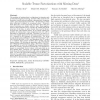Free Online Productivity Tools
i2Speak
i2Symbol
i2OCR
iTex2Img
iWeb2Print
iWeb2Shot
i2Type
iPdf2Split
iPdf2Merge
i2Bopomofo
i2Arabic
i2Style
i2Image
i2PDF
iLatex2Rtf
Sci2ools
110
Voted
SDM
2010
SIAM
2010
SIAM
Scalable Tensor Factorizations with Missing Data
The problem of missing data is ubiquitous in domains such as biomedical signal processing, network traffic analysis, bibliometrics, social network analysis, chemometrics, computer vision, and communication networks--all domains in which data collection is subject to occasional errors. Moreover, these data sets can be quite large and have more than two axes of variation, e.g., sender, receiver, time. Many applications in those domains aim to capture the underlying latent structure of the data; in other words, they need to factorize data sets with missing entries. If we cannot address the problem of missing data, many important data sets will be discarded or improperly analyzed. Therefore, we need a robust and scalable approach for factorizing multi-way arrays (i.e., tensors) in the presence of missing data. We focus on one of the most well-known tensor factorizations, CANDECOMP/PARAFAC (CP), and formulate the CP model as a weighted least squares problem that models only the known entri...
Related Content
| Added | 29 Oct 2010 |
| Updated | 29 Oct 2010 |
| Type | Conference |
| Year | 2010 |
| Where | SDM |
| Authors | Evrim Acar, Daniel M. Dunlavy, Tamara G. Kolda, Morten Mørup |
Comments (0)

